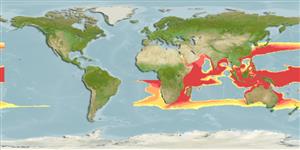Environment: milieu / climate zone / depth range / distribution range
Ekologi
laut; kisaran kedalaman 0 - 50 m (Ref. 106604). Tropical
Indo-West Pacific: eastern coast of Africa to Indonesia.
Length at first maturity / Size / Weight / umur
Maturity: Lm ?, range 115 - ? cm
Max length : 119 cm WD jantan/; (Ref. 11441); 120.0 cm WD (female); Berat maksimum terpublikasi: 30.0 kg (Ref. 11228)
deskripsi pendek
Morfologi | Morfometrik
A small devilray with a short head bearing short head fins; dorsal fin white-tipped, and pectoral fins with slightly curved tips; upper surface with no denticles and tail shorter than disc, with no spine (Ref. 5578). Dark brown above, white below (Ref. 5578).
Found in coastal and oceanic waters (Ref. 5578). Feeds on plankton (Ref. 30573). Ovoviviparous (Ref. 50449). Generally found in schools, leaping out of the water (Ref. 11228). Caught rarely in the tuna gillnet fisheries. Utilized for its gill filter plates (high value), meat, cartilage and skin (Ref.58048).
Life cycle and mating behavior
Kematangan | Reproduksi, perkembang biakan | Pemijahan | telur-telur | Fecundity | Larva
Exhibit ovoviparity (aplacental viviparity), with embryos feeding initially on yolk, then receiving additional nourishment from the mother by indirect absorption of uterine fluid enriched with mucus, fat or protein through specialised structures (Ref. 50449). Probably giving birth to only one pup; born at ~31 cm WD (Ref.58048).
Randall, J.E., 1995. Coastal fishes of Oman. University of Hawaii Press, Honolulu, Hawaii. 439 p. (Ref. 11441)
Status IUCN Red List (Ref. 130435)
ancaman kepada manusia
Harmless
penggunaan manusia
Perikanan: nilai komersial kecil
informasi lanjut
Umur / SaizPertumbuhanpanjang-beratpanjang-panjangukuran frekuensiMorfometrikMorfologiLarvaDinamika larvapemulihanKelimpahanBRUVS
AcuanBudidaya airprofil budidaya airStrainGenetikaElectrophoresesDiturunkanPenyakit-penyakitPengolahanNutrientsMass conversion
mitraGambarStamps, Coins Misc.Suara-suaraCiguateraKecepatanTipe renangArea insangOtolithsOtakPenglihatan / visi
Alat, peralatan
laporan khas
muat turun XML
Sumber internet
Estimates based on models
Preferred temperature (Ref.
123201): 23.9 - 29.1, mean 28 °C (based on 1852 cells).
Phylogenetic diversity index (Ref.
82804): PD
50 = 0.5005 [Uniqueness, from 0.5 = low to 2.0 = high].
Bayesian length-weight: a=0.01000 (0.00244 - 0.04107), b=3.04 (2.81 - 3.27), in cm total length, based on all LWR estimates for this body shape (Ref.
93245).
Trophic level (Ref.
69278): 3.4 ±0.45 se; based on food items.
Daya lenting (Ref.
120179): Rendah, Waktu penggandaan populasi minimum 4.5 - 14 tahun (Fec assumed to be <100).
Fishing Vulnerability (Ref.
59153): Very high vulnerability (85 of 100).
